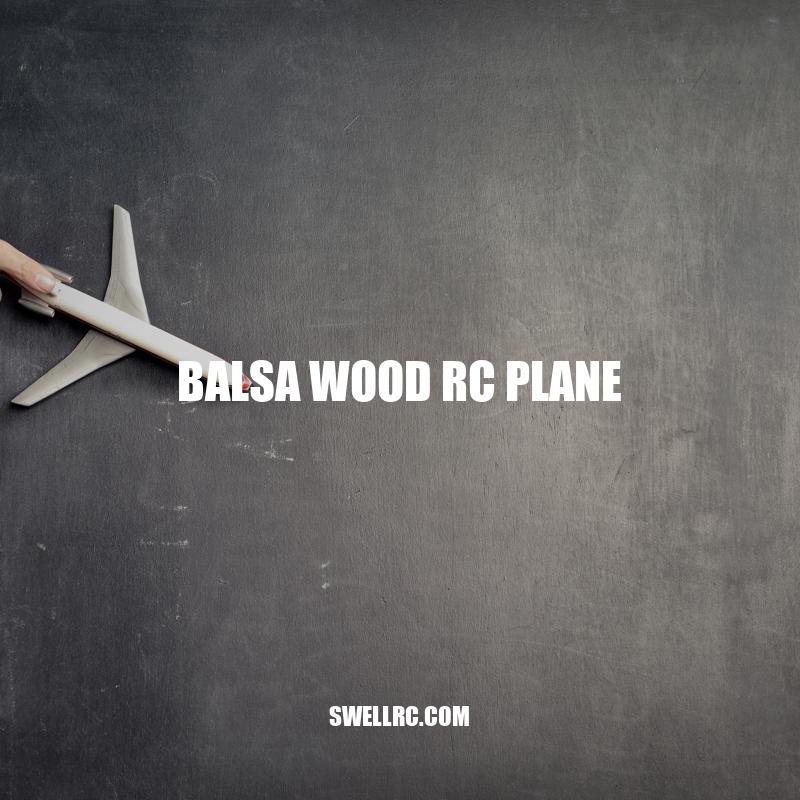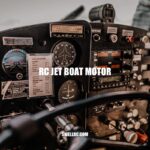Building a Balsa Wood RC Plane: A Comprehensive Guide
Balsa wood RC planes are a popular choice among remote control enthusiasts and hobbyists due to their lightweight and durability. Balsa wood is a type of wood that is grown in Central and South America and is well-known for its extremely lightweight and porous nature. This wood is highly valued in the field of model making due to its strength-to-weight ratio, which is even higher than that of aluminum. For this reason, balsa wood is a popular choice of material in the construction of airplanes and spacecraft. Balsa wood is perfect for building RC planes as it has excellent resistance to compressive stress, making it ideal for constructing the airfoils of the plane. Additionally, its natural ability to absorb impact makes it sturdy enough to withstand crashes and bumps while flying. Construction with balsa wood is also easy and quick, and an RC plane made from this wood can be assembled in just a few hours. With its unique properties and ease of use, balsa wood has become a favorite among RC plane enthusiasts looking to build their own planes.
Advantages of Using Balsa Wood in RC Planes
There are several advantages to using balsa wood in the construction of RC planes. These include:
- Lightweight: The lightweight nature of balsa wood makes it ideal for RC planes as it allows the planes to fly at high speeds and achieve maximum altitude.
- Durable: Balsa wood is also highly durable and is known for its resistance to compressive stress, making it ideal for constructing the airfoils of RC planes.
- Easy to Work With: Balsa wood is very easy to work with and can be cut and shaped to any desired design. This makes it easy for enthusiasts to create custom planes that are tailor-made to their preferences.
For those interested in building their own balsa wood RC plane, there are many resources and products available online to help get started. Websites such as rcgroups.com and modelaviation.com provide a wealth of information on building and flying RC planes. Additionally, there are various balsa wood plane kits available for purchase that come with all of the necessary materials and instructions for assembly. Some popular balsa wood RC plane kits include the Sig Kadet LT-40 Kit and the FlyZone Micro Calypso Glider.
What is balsa wood good for?
Balsa wood is a lightweight and versatile material that has various uses, including:
- Model-making: Balsa wood’s lightness and ease of shaping make it ideal for creating models of airplanes, boats, and other structures that need to be lightweight yet sturdy.
- Crafting: Balsa wood can be used for making various crafts and DIY projects, such as picture frames, jewelry boxes, and decorative items.
- Architectural models: Balsa wood is commonly used by architects and designers to create intricate models of buildings, landscapes, and cityscapes.
- Fishing lures: Balsa wood is also popular among fishing enthusiasts as a material for making custom fishing lures.
Balsa wood can be found at many craft and hobby stores, as well as online retailers such as Amazon and Michaels.
Designing a Balsa Wood RC Plane
Designing a balsa wood RC plane involves several steps, including:
- Creating a Blueprint: The first step in designing an RC plane is to create a blueprint of the aircraft. The blueprint includes details on the wing, fuselage, and tail sections of the plane.
- Choosing Components: Once the blueprint is complete, the designer must choose the components that will be used to construct the plane. Other materials like plastic and metal may be used for the motor, control surfaces, and landing gear.
- Building the Frame: Balsa wood is used to build the frame of the plane. The wood can be cut and sanded to the desired shape and assembled using glue or other adhesives.
- Attaching Components: Once the frame is complete, the other components can be attached to it. This includes the motor, control surfaces, and landing gear.
- Testing the Plane: Before the plane is flown, it must be thoroughly tested to ensure that it is safe and stable. This involves testing the controls, balance, and stability of the plane.
Interesting Fact: Balsa wood is not only used in RC planes but also in model bridges, surfboards, and even as a core material in the construction of wind-turbine blades.
For those interested in designing and building their own balsa wood RC plane, there are many online resources available. Websites such as rcgroups.com and modelaviation.com offer tutorials, forums, and advice on plane design and construction. Additionally, some companies offer custom design services and can create a balsa wood RC plane based on the customer’s specifications.
| Website Name | Type of Resource | Description |
|---|---|---|
| rcgroups.com | Website | A community-based website that offers forums, articles, and tutorials on RC plane design and construction. |
| modelaviation.com | Website | Offers a variety of RC plane resources, including tutorials and articles on plane design and construction. |
| FlyZone Micro Calypso Glider | Product | Balsa wood RC plane kit that comes with all necessary materials and instructions for assembly. |
Why is balsa wood used for RC plane?
Balsa wood is a popular choice for RC planes due to its high strength-to-weight ratio. Other reasons include:
- Easy to shape and work with
- Low cost compared to other lightweight materials
- Naturally buoyant, which helps with stability during flight
- Good vibration damping properties
Additionally, balsa wood is a renewable resource and is environmentally friendly compared to synthetic materials. If you’re looking for balsa wood for your RC plane, check out websites like balsawoodinc.com or hobbylinc.com for a variety of options.
Building and Flying a Balsa Wood RC Plane
Building and flying a balsa wood RC plane is a fun and rewarding experience. Here are the steps involved in building and flying an RC plane:
- Building the Plane: Building a balsa wood RC plane involves cutting and sanding the wood to shape, and assembling the various parts of the plane.
- Testing the Plane: Once the plane is built, it must be thoroughly tested to ensure that it is safe and stable. This involves testing the controls, balance, and stability of the plane.
- Learning to Fly: Flying an RC plane takes practice and patience. The pilot will need to learn how to control the plane using a remote control device. This includes learning how to control the throttle, direction, and elevation of the plane.
- Flying Tips: Here are some tips for flying an RC plane:
- Choose a spacious and open area to fly in.
- Start small and practice on calm days with minimal wind.
- Be patient and take things slowly, especially when first learning to fly.
For those interested in learning more about flying a balsa wood RC plane, there are many online resources available. Websites such as rcgroups.com and modelaviation.com offer tutorials, tips, and advice on flying techniques. Additionally, there are many videos available on YouTube that offer step-by-step instructions on the basics of RC plane flying.
For beginners looking to start with a pre-built balsa wood RC plane, there are many options available as well. The FlyZone Micro Calypso Glider is a popular balsa wood RC plane kit that comes with all necessary materials and instructions for assembly. Other options include the Dancing Wings Hobby S0801 Balsa Wood RC Plane and the Guillow’s Balsa Wood Jetfire Glider.
| Product Name | Type of Product | Description |
|---|---|---|
| FlyZone Micro Calypso Glider | RC Plane Kit | Balsa wood RC plane kit that comes with all necessary materials and instructions for assembly. |
| Dancing Wings Hobby S0801 Balsa Wood RC Plane | RC Plane Kit | DIY balsa wood RC plane kit that comes with all necessary materials and instructions for assembly. |
| Guillow’s Balsa Wood Jetfire Glider | Glider Kit | Balsa wood glider kit that can be converted to an RC plane with additional materials and modifications. |
What parts do you need to build a RC plane?
To build an RC plane, you need the following parts:
- Powerplant – electric or combustion engine
- Radio receiver/transmitter
- Servos to control the plane’s movements
- Battery pack for electric powerplants
- Fuel tank for combustion engines
- Airframe – made of wood, foam, or composite materials
- Propeller for propulsion
- Control surfaces – a rudder, elevator, and ailerons
In addition, you may need other accessories such as glue, hinges, control horns, landing gear, and aileron connectors. Some popular websites for buying RC airplane parts include Horizon Hobby and Tower Hobbies.
Conclusion
In conclusion, building and flying a balsa wood RC plane is a fun and rewarding hobby that can provide hours of entertainment. With its lightweight and durable characteristics, balsa wood is the ideal material for constructing RC planes, making it a popular choice among hobbyists and enthusiasts alike.
When building an RC plane from balsa wood, it is important to follow the proper design and construction techniques to ensure that the plane is safe and stable. Additionally, it is important to take the time to learn how to fly the plane properly to avoid crashes and other mishaps.
Overall, flying an RC plane made from balsa wood can be a thrilling and exciting experience that is sure to provide hours of entertainment for those who are willing to put in the time and effort to learn. Whether you are an experienced pilot or just starting out, building and flying a balsa wood RC plane is an adventure that is worth undertaking.



